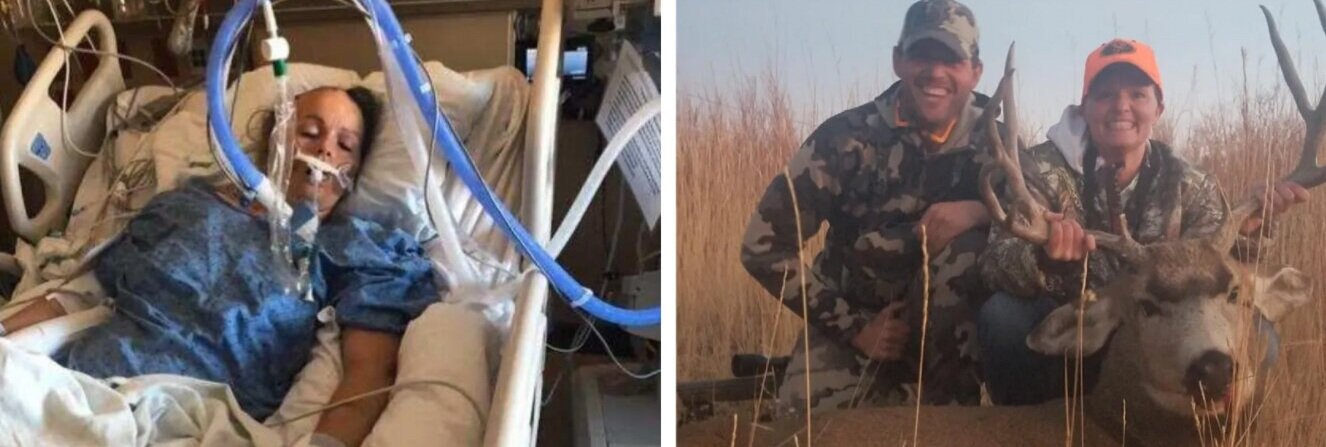Lindsay’s Story
On August 30, 2019, Lindsay was preparing for a Labor Day camping trip with her husband, Kurt, and their three children. She jokes that she’s really a redneck at heart – loving all things outdoors, and taking every opportunity to sneak off for a few days of camping, hunting or horseback riding together.
Lindsay had wanted to have everything ready to go so the family could leave as soon as Kurt got home from work. But as she was carrying groceries in from the car, she suddenly developed what she calls “the worst headache you can imagine.” The pain was so intense that she knew something was very wrong, and she picked up the phone and called her mom, who taught at a nearby school. The conversation was brief. Lindsay ended it with one word: “Hurry.”
When her mom got to the house, less than two minutes later, Lindsay was having a seizure. Her mom made two quick phone calls – the first to 911 and the next to Kurt – then held Lindsay close while they waited for an ambulance.
When Lindsay arrived at the San Pete Valley Hospital, she could hear muffled voices and see hazy outlines of people, like she was looking through a thick fog. She was vaguely aware that her husband and children were there, and someone was taking pictures. What she didn’t know was that the nurses had told her mom to get the kids there, because it might be their last chance for a family picture.
A CT scan showed that Lindsay had a severe brain bleed, caused by moyamoya syndrome, a rare condition in which the blood vessels that supply blood to the brain become narrowed. The ER doctor at San Pete Valley sent the scan to Utah Valley Hospital, 60 miles to the north, and within minutes, a life flight helicopter was on its way to pick up Lindsay.
Dr. John Edwards was the neurosurgeon on call at Utah Valley. He pulled up the CT scan while he waited for the helicopter, and he knew immediately that Lindsay was in a dire condition. The fluid spaces in the brain (ventricles) were completely filled with blood and she had blood in an area of the brain called the basal ganglia, which causes swelling and pressure on the brain. When Lindsay arrived at Utah Valley, she was non-responsive. In fact, she was in a coma.
Dr. Edwards decided to admit her to the ICU and closely monitor her neurologic status. He counseled the family on options for Lindsay, recommending that surgery be performed the following morning. This would allow some time for the offending blood vessel to completely stop bleeding and give Dr. Edwards time to acquire the tools he felt would be best for the surgery.
That night seemed like an eternity to Lindsay’s family. They waited in the hospital lounge and prayed like they had never prayed before. In the meantime, Dr. Edwards worked to get a retractor system shipped overnight.
The following morning, a repeat CT scan showed increased build-up of spinal fluid in the brain, but no additional bleeding. That indicated the bleeding had stopped, but the accumulated blood had to be removed as soon as possible.
Dr. Edwards performed surgery through a small hole in the skull. A 14 mm tubular port was advanced through part of the frontal lobe into the blood clot. This gave the blood some place to go, and every time Lindsay’s heart beat, a small amount of blood moved into the port. This allowed Dr. Edwards to suction the blood out a little at a time, and eventually remove the entire clot without causing additional bleeding or harm to the brain.
After the surgery, Dr. Edwards spoke to Lindsay’s family and reported that things went as well as possible, and though she still had a long road to recovery, he was hopeful.
Dr. Edwards uses the latest advancements in medical technology to perform the most minimally-invasive surgeries he possibly can in any given circumstance. This usually ensures that his patients spend less time in surgery, bleed less, and as a result, recover faster.
Lindsay spent a week in the ICU, gradually regaining consciousness. Kurt stayed by her side, and her mom brought the kids for frequent visits. Lindsay’s children rubbed her legs and held her hand. They knew their mom would love that, and believed it would help her. And it did. “I could feel that,” Lindsay said, “and it made me want to fight harder. My kids are my life. I LIVE for those kids, and I wanted to do everything I could to get better – for them.”
“I owe my life to Dr. Edwards.”
Each day Lindsay was able to hear more, see more, and do more. She spent time recovering in the rehab unit at the hospital. She eventually began to feel like herself again, and on September 27th – exactly four weeks after she came to Utah Valley Hospital, she said good-bye to the medical staff, and returned home with Kurt and the kids.
Lindsay says she will never again take anyone or anything for granted. “I am immensely grateful just to be able to go for a walk, make dinner, even do the dishes. I find joy in everything – even the mundane things.”
When Lindsay came to clinic six weeks after her surgery, Dr. Edwards reviewed her CT scan and neurologic exam. They were both essentially normal. Lindsay asked if she could resume regular activity, and Dr. Edwards gave her full clearance.
In November, less than three months after surgery, Lindsay and her family went hunting together. It was their best trip ever.
“I am so lucky to have had Dr. Edwards,” Lindsay said. “I owe my life to him. That’s how I feel. And I know with 100% certainty that the Lord was looking out for me.”
#summitbrainandspine
#dredwards
#lifeisback

